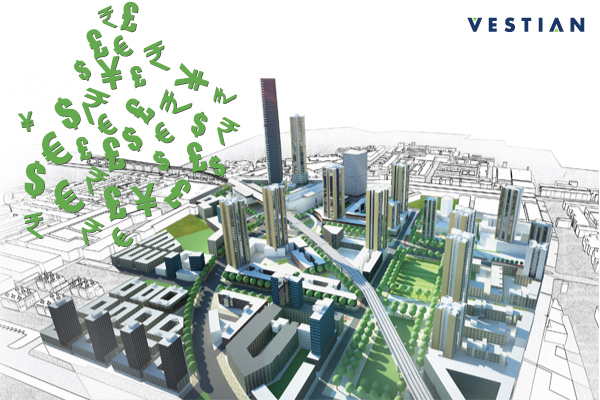Part 7 of the series identifies real estate concepts, standards and outlook involved in execution of Smart Cities’ Initiative in India
The Smart Cities mission has created a strong and positive impact on the real estate sector in India. This sector is expected to grow from USD121 billion in 2013 to USD853 billion by 2028, furthermore growing social, economic and other ancillary businesses.
By 2020, India will emerge as the world’s 3rd largest construction market. Under the scheme ‘Housing for All,’ the government plans to build a total of 60 million homes (40 million in rural areas and 20 million in urban areas – as 11.5 million homes are added every year) by 2022; INR 22,407 crore has been allocated for the same. This will include Smart buildings, which will save 30% water and 40% energy usage, and reduce 10-30% on maintenance of buildings. Most importantly, citizens will have an active role in deciding, which areas of the existing Tier 1, 2 or 3 cities need to be upgraded with smart strategies. There will be an increased demand for commercial spaces, hotels, service apartments, shopping malls, along with residential spaces. MNCs offering employment will require high quality and well-developed infrastructure. The demand will increase for manufacturing and industrial hubs too. Real estate developers are also looking at implementing ICT in their projects.
According to a study by RICS, 44% of capital investments for Smart Cities mission in India will be in built environment across area-based and city-wide developments. Area-based developments involves transforming Greenfield areas into thriving urban hubs from scratch; while city-wide developments involve improving, reviving, and re-creating existing areas. Various strategies like retrofitting, re-development and pan-city solutions will enhance the design of city-wide developments making them more efficient and livable. This would involve increasing the Floor Space Index (FSI) of specific region(s) or corridor(s) in the semi-urban set-up. Subsequently, property values along these areas will rise and result in better rental yield, increased built up area and Transferable Development Rights (TDR) benefits. Similarly, re-development envisages effective replacement of an existing built-up environment that is >50 acres to a new layout with enhanced infrastructure. It involves concepts like “mixed land use” for re-creation of land for commercial, residential, retail and healthcare purposes, leading to densification and high ground coverage. Meanwhile, Greenfield developments involve incorporation of smart solutions in a previously vacant area (more than 250 acres) using innovative planning, financing and implementation tools. These tools include land pooling and land reconstitution to develop regional urban hubs with provision for affordable housing, improved physical infrastructure and connectivity alongside uninterrupted access to electricity and water. These areas/ sub-divisional towns will witness maximum real estate activity in terms of design, construct and sustainable practices. Governing bodies such as Indian Green Building Council (IGBC) alongside the Smart Cities’ Apex Committee are anticipated to impose compulsory mandates for green standards for energy efficiency, water saving and waste management for new constructions.
Governing bodies will increasingly take on a larger role in developing construction standards and upgrading the existing real estate regulations. Specific building codes for commercial, industrial, residential, healthcare, scientific research, entertainment, aviation, hospitality, education and retail constructions aimed to improve the overall environmental performance, will soon become a reality. Airports and hotels will use maximum smart building technologies, with residential housing using the least, along with a three-fold growth in building automation and control systems. With a target of more than 3,124 green building projects by 2030, 617 of them are already certified and providing services.
While contribution of real estate to the country’s GDP is expected to rise from 6% to 10-12% by 2022, the need for organized real estate players across the sub-continent is also anticipated to grow. Most of the cities covered under Smart Cities Program comprise of special economic zones/investment regions, with modified tax structures and laws that favor foreign investments. This will lead to a conducive environment for investors, realtors and HNIs keen to invest in the Indian Smart Cities. Standardized processes and procedures will help revamp the development of the sector and pump ~20 % more funds from FDI into the Indian realty space. Implementation of green standards, GST and RERA Act (March 2016) will not only increase credibility of the Indian developers but also go a long way in setting the tone for a more transparent and accountable real estate sector.
A judicious approach, in terms of project timelines, funds, governing policies and global best practices, to create urban, semi-urban, financial destinations, cultural centers and tourist hubs will encourage renewed interest in the country’s real estate space from PE funds and end-users alike.
In the next and last part of this series, we will take a look at Smart Cities worldwide.
